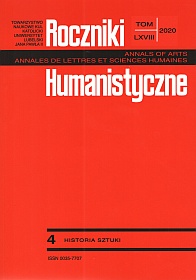The penitential programme in the former missionary church in Siemiatycze
Abstract
The Council of Trent confirmed the Church’s teaching on the law of penance, focusing on confession of sins and sacramental absolution. It was a response to the erroneous teaching of Protestantism, which rejected most of the sacraments by recognising only the sacraments of baptism and the Eucharist. The sacrament of penance was established by Christ on the day of the resurrection. The apostles, followed by priests, received the power to forgive sins.
The doctrine of the Holy Sacraments, and especially of penance and the Eucharist, was preached by the members of the Congregation of the Mission founded by Vincent de Paul during missions in many European countries. The main task of the missionaries was to encourage the faithful to confess their sins and receive the sacrament of penance. This sacrament was perceived as a spiritual cure for the sinners and through repentance they could return to the merciful God.
The missionaries came to Siemiatycze in 1717. They took over the parish and the church, which they expanded and re-equipped, inter alia by adding six oak regency confessionals (ca. 1744). The finials of the confessionals featured paintings of penitents absolved by God: Mary Magdalene, King David, the prodigal son and St. Peter. The purpose of the scenes in the paintings was to make it clear to the faithful that the sacrament of penance is a sign that God never leaves people, but always opens the way for their return. Through the paintings in the finials, the sinners were to be assured that repentance and confession of sins to the priest and the penance given by him lead to the forgiveness of sins by God by virtue of the “power of the keys” – the priestly absolution. The images in the confessionals also indicated that for the sinner, the confession is the way back to and the source of God’s mercy. This was emphasised by two consecutive images in the confessionals: the Good Shepherd finding the stray sheep and the scene showing St. Peter and Christ at the moment of handing over the keys. For the faithful, the figure of St. Peter indicated that he would strengthen and guard the faith against all human weakness.
References
Dokumenty soborów powszechnych, red. Arkadiusz Baron i Henryk Pietras, t. 4, Wydawnictwo WAM, 2007.
Gontarek, Arkadiusz. „Treści ideowe polskich nowożytnych konfesjonałów jako wyraz potrydenckiego nauczania Kościoła”. Artifex Novus, vol. 3, 2019, ss. 96-113. Wydawca IHS UKSW, 2019.
Katalog zabytków sztuki w Polsce. Seria nowa, t. 12: Województwo białostockie, z. 1: Siemiatycze, Drohiczyn i okolice, red. Maria Kałamajska-Saeed, Instytut Sztuki PAN, 1996.
Kitowicz, Jędrzej. Opis obyczajów za panowania Augusta III, t. I, red. Roman Pollak, Zakład Narodowy im. Ossolińskich – Wydawnictwo, 2003.
Kobielus, Stanisław. „Konfesjonał”. Encyklopedia Katolicka, t. 9, Towarzystwo Naukowe KUL, 2002, kol. 579-580.
Mazur, Sławomir. Dzieje parafii rzymskokatolickiej w Dołubowie w latach 1465-1939. Wydawnictwo Intergraf, 2010.
Mezzadri, Luigi. „Misje ludowe”. Słownik duchowości wincentyńskiej, t. 1, red. Jan Dukała i Władysław Bomba, Instytut Teologiczny Księży Misjonarzy, 1997.
Nasiorowski, Sławomir. „List pasterski” kard. Bernarda Maciejowskiego. Redakcja Wydawnictw KUL, 1992.
Salezy, Franciszek. Filotea, czyli droga do życia pobożnego, red. Aleksander Jełowicki, Wydawnictwo AA, 2009.
Święty Wincenty a Paulo. Duchowość, teksty, red. Jan Dukała i Stanisław Wypych, Instytut Wydawniczy Księży Misjonarzy „Nasza Przeszłość”, 1987.
Św. Wincenty a Paulo. Listy, konferencje, dokumenty, t. 1: Listy (1607-1639). Oprac. Pierre Coste. Tłum. Józef Kapuściak, Wydawnictwo Instytutu Teologicznego Księży Misjonarzy, 2015.
Copyright (c) 2020 Roczniki Humanistyczne

This work is licensed under a Creative Commons Attribution-NonCommercial-NoDerivatives 4.0 International License.





